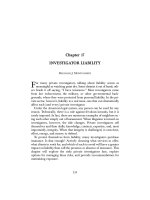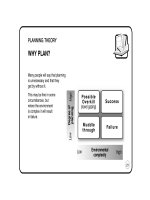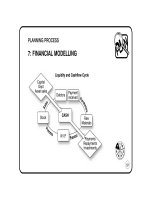Australian Guide to Legal Citation (3rd edition) potx
Bạn đang xem bản rút gọn của tài liệu. Xem và tải ngay bản đầy đủ của tài liệu tại đây (3.09 MB, 334 trang )
ALIAN GUIDE TO LEGAL
AUSTRA LIA N
CITATION AUST
AUSTRALIAN GUIDE TO
GUIDE TO LE GAL CITA
AUSTRA
TO LEGAL CITATION
TO LE GAL CITATION
AUSTRALIAN GUIDE
TO
LEGAL CITATION
Third Edition
Melbourne University Law Review Association Inc
in collaboration with
Melbourne Journal of International Law Inc
Melbourne
2010
AUSTRALIAN GUIDE
TO LEGAL CITATION
Third Edition
Published and distributed by
the Melbourne University Law Review Association Inc
in collaboration with the Melbourne Journal of International Law Inc
National Library of Australia Cataloguing-in-Publication entry
Australian guide to legal citation / Melbourne University Law Review Association Inc.,
Melbourne Journal of International Law Inc.
3rd ed.
ISBN 9780646527390 (pbk.).
Bibliography.
Includes index.
Citation of legal authorities - Australia - Handbooks, manuals, etc.
Melbourne University Law Review Association
Melbourne Journal of International Law
808.06634
First edition 1998
Second edition 2002
Published by:
Melbourne University Law Review Association Inc
Reg No A0017345F · ABN 21 447 204 764
Melbourne University Law Review Telephone: (+61 3) 8344 6593
Melbourne Law School Facsimile: (+61 3) 9347 8087
The University of Melbourne Email: <>
Victoria 3010 Australia Internet: <>
Melbourne Journal of International Law Inc
Reg No A0046334D · ABN 86 930 725 641
Melbourne Journal of International Law Telephone: (+61 3) 8344 7913
Melbourne Law School Facsimile: (+61 3) 8344 9774
The University of Melbourne Email: <>
Victoria 3010 Australia Internet: <>
© 2010 Melbourne University Law Review Association Inc and Melbourne Journal of International
Law Inc. This work is protected by the laws of copyright. Except for any uses permitted under the
Copyright Act 1968 (Cth) or equivalent overseas legislation, no part of this work may be reproduced,
in any manner or in any medium, without the written permission of the publisher. All rights reserved.
The Australian Guide to Legal Citation has been adopted by:
Adelaide Law Review
Alternative Law Journal
Australasian Journal of Natural Resource Law and Policy
Australia and New Zealand Maritime Law Journal
Australian Indigenous Law Review
Australian International Law Journal
Australian Law Librarian
Bond Law Review
Constitutional Law and Policy Review
Deakin Law Review
eLaw Journal: Murdoch University Electronic Journal of Law
Elder Law Review
Federal Law Review
Flinders Law Journal
Indigenous Law Bulletin
James Cook University Law Review
Journal of Applied Law and Policy
Journal of the Australasian Law Teachers Association
Journal of the Australasian Tax Teachers Association
Journal Jurisprudence
Journal of Law and Financial Management
Journal of Law, Information and Science
Journal of Social Security and Workers Compensation
Legal Education Review
Legal Issues in Business
Media and Arts Law Review
Melbourne Journal of International Law
Melbourne University Law Review
Monash University Law Review
New Zealand Armed Forces Law Review
Newcastle Law Review
Proctor
Public Space: The Journal of Law and Social Justice
Queensland University of Technology Law and Justice Journal
Revenue Law Journal
Sports Law eJournal
Sydney Law Review
University of New England Law Journal
University of New South Wales Law Journal
University of Notre Dame Australia Law Review
University of Tasmania Law Review
University of Western Sydney Law Review
The Melbourne University Law Review Association and
the Melbourne Journal of International Law
gratefully acknowledge the generous support of the sponsors of
the third edition of the Australian Guide to Legal Citation.
v
Foreword to the Third Edition
The third edition of the Australian Guide to Legal Citation (‘Guide’) deserves
celebration. The Guide is the successor to the Melbourne University Law Review Style
Guide, the bane and vade mecum of student editors for many years. The first edition of
the Guide appeared in 1998 and the second in 2002. This third edition is considerably
longer and more detailed than its predecessors, offering guidance on the citation of
new sources of law.
Until I worked on the Melbourne University Law Review as a student in the 1970s, I
was oblivious to the delights, agonies and obsessions of editorial style and citation
methods. That experience imparted enduring respect for well-tempered punctuation as
well as accurate and judicious footnoting.
It is easy to dismiss rules of punctuation and legal citation as the province of pedants
and to imply that attention to such matters privileges style over substance.
Punctuation, however, can be critical to meaning and clarity. Lynne Truss
acknowledges this significance in her charming meditation on punctuation, Eats,
Shoots and Leaves, which she dedicates:
To the memory of the striking Bolshevik printers of St Petersburg who, in 1905,
demanded to be paid the same rate for punctuation marks as for letters, and thereby
directly precipitated the first Russian Revolution.
1
As for citation, scholars have a responsibility to acknowledge the sources of their
information and ideas carefully so that they can be readily traced by their readers. In
this sense, citation practices are akin to musical scales — technical exercises that
ground scholarly sonatas.
The third edition expands and updates earlier versions of the Guide. Now legal
scholars have a stern but reliable guide to the vexing issue of the use of ellipses in
quotations, or the citation of parties’ submissions in court cases. The distinction
between em- and en-dashes is helpfully explicated. One particularly welcome change
from earlier editions is the inclusion of examples for almost all rules. The third edition
also contains a number of tables that present complex rules in a simple and accessible
manner.
This volume mirrors the increasing significance of both comparative and international
law in Australian legal scholarship. The earlier single chapter on the citation of
international materials has now become seven chapters. The international section
(Part IV) devotes considerable attention to treaties and the documents generated by
international institutions. It includes an entirely new chapter on the citation of
documents from international criminal tribunals, reflecting the astonishing growth in
the law in this area over the past decade.
1
Lynne Truss, Eats, Shoots and Leaves: The Zero Tolerance Approach to Punctuation
(Profile Books, 2003) v.
vi
Part V introduces rules for citing legal materials from China, France, Germany,
Malaysia, Singapore and South Africa and contains extensive revisions of rules
relating to the United Kingdom and the United States. Such guidelines will enhance
the accessibility of foreign legal sources and thus gently erode Australian legal
parochialism.
The third edition is the product of intense and detailed work. It is meticulous without
being stultifying. The authors are respectful sticklers working on behalf of readers
everywhere and all Australian legal scholars will benefit from the careful scrutiny and
sensibility of the three generations of the Guide’s authors.
Sticklers unite! Like the printers of St Petersburg, the authors of this Guide take the
conventions of language and research seriously. May this compendium repay their
hard work by encouraging precision in prose and clarity in citation.
Hilary Charlesworth
Professor of Law and ARC Federation Fellow
The Australian National University
Melbourne University Law Review Editor 1979
January 2010
vii
Foreword to the First Edition
Many publishers and some publications have their own Style Guides. For years, the
editors of the Melbourne University Law Review referred to the Style Guide published
by the Review’s constituent body to solve problems of how to cite materials referred to
in the articles and notes appearing in each issue. Now the Melbourne University Law
Review Association has produced an Australian Guide to Legal Citation.
The project is ambitious. As its Preface says, the Guide ‘attempts to set down and
clarify citation customs where they exist, and to determine the best practice where no
particular custom has been established’. In so doing the Association seeks to emulate
other, long established and authoritative citation guides published by university law
reviews. Of these, the ‘Bluebook’ is, perhaps, the best known. Published by a group of
law reviews led by the Harvard Law Review, The Bluebook: A Uniform System of
Citation has become the standard work in the field in the United States and has now
passed through many editions. Other university law reviews have entered the field, for
example, the University of Chicago Manual of Legal Citation and, in Canada, the
Canadian Guide to Uniform Legal Citation published by the McGill Law Journal.
Not all such works attract only praise. Judge Posner has written of the Bluebook that it
‘creates an atmosphere of formality and redundancy in which the drab, Latinate,
plethoric, euphemistic style of law reviews and judicial opinions flourishes’.
1
But this
Guide is not, and does not pretend to be a guide to legal style any more than it is a
guide to substantive law. The Guide is concerned only with how sources may be
identified. Its principles require that they be identified clearly and accurately, simply
and efficiently, and with due sensitivity. The way in which the material from those
sources is then used and presented is for the author to choose.
It is for the author to develop a style that will engage the reader. Every reader will, no
doubt, wish that the style chosen is not ‘drab, Latinate, plethoric [or] euphemistic’. If it
is the fault will lie with the author not the Guide.
Justice K M Hayne
Justice of the High Court of Australia
Melbourne University Law Review Editor 1966
Melbourne
19 March 1998
1
Richard Posner, ‘Goodbye to the Bluebook’ (1986) 53 University of Chicago Law
Review 1343, 1349.
viii
Preface to the Third Edition
The third edition of the Australian Guide to Legal Citation is the product of
collaboration between the Melbourne University Law Review Association and the
Melbourne Journal of International Law. This edition marks the first time that the
Review and the Journal have worked together on the AGLC. This collaboration has
made this edition a more comprehensive, thorough and rigorous citation guide. As in
previous editions, the AGLC aims to codify and clarify Australian citation customs
where they are settled and suggests best practice where no settled custom exists.
History of the AGLC
The AGLC was first published by the Melbourne University Law Review Association
in 1998. The second edition, marking a significant revision and expansion of the
AGLC, was published in 2002. Since its first publication, the AGLC has become the
authoritative legal citation guide within Australia, used by practitioners, law students
and academics alike. It is currently prescribed by law schools and law journals around
Australia as their official legal citation guide, the list of law journals who have adopted
the AGLC reflecting the enthusiasm with which it has been received.
The Third Edition
The third edition of the AGLC marks a comprehensive restructure and revision. For
ease of use, the AGLC has been divided into six Parts, separated by tabs, to allow
readers to reach relevant rules quickly. For ease of reference, tables have also been
included where lists of information were previously provided. All examples from the
second edition have been replaced, and further examples to illustrate the possible
permutations under each rule have been added. This, along with the 14 new chapters
included, is the main reason for the increased length of the third edition.
Importantly, the general rules chapter has been expanded and reordered to improve the
flow and clarity of rules generally applicable. This has also allowed the removal of
repetition from later chapters. The Australian cases and legislation chapters have been
carefully updated in order to ensure that the AGLC remains comprehensive and current
for Australian materials. A particularly significant change has been the vastly
expanded and updated international law section (now Part IV of the AGLC) and the
addition of several new chapters for materials from foreign jurisdictions (in Part V).
Important inclusions are:
clarified rules for subsequent references;
rules on the use of paragraph numbers in pinpoint references for cases and
secondary sources;
a rule requiring publisher information in citations of books;
a rule on citing definitions in legislative materials;
revised and comprehensive rules on material from the United Nations,
European supranational institutions and the World Trade Organization;
ix
new rules for citing international criminal tribunal decisions and decisions in
investor–state disputes;
new chapters for materials from China, Hong Kong, France, Germany,
Malaysia, Singapore and South Africa; and
a chapter providing guidance on how to cite legal materials from jurisdictions
not specifically covered by the AGLC.
Acknowledgements
Members of the Melbourne University Law Review Association and the Melbourne
Journal of International Law have been involved in production of this edition of the
AGLC over the last four years. Additionally, the third edition of the AGLC has been
subject to a comprehensive external feedback process, which took place from
September to December 2009. Of course, the Review and the Journal had previously
received much feedback on the AGLC, which was also very helpful in compiling the
third edition and for which we are grateful.
We thank first and foremost the past and present members of the ‘AGLC3 Committee’
for their work in revising and expanding the AGLC: Xiu Jing Chang, James Ellis,
David Foster, Christopher Hibbard, Errol Lloyd, Luke Pallaras, Miranda Webster and
Anna Zhang. The 2008 leaders of the Committee, May-Ling Low and Sunny Leow,
deserve our gratitude for laying the groundwork for the third edition of the AGLC.
We would like to express our thanks to all those from the Melbourne Law School,
from external bodies and organisations and past Members of the Review and Journal
who took the time to provide us with feedback on an Exposure Draft of the third
edition. This process resulted in a table of over 150 pages of suggestions for
improvements to the AGLC, all of which we have carefully considered and many of
which we have gratefully adopted. Our thanks go to Elizabeth Adeney, Renée Amyot,
Alice Anderson, Adrian Bates, Laura Bellamy, Debbie Bennett, Bruce Bott, Sonia
Brownhill, Adam Bushby, Howard Choo, Philip Chung, Katherine Cooke, the Hon
Justice Clyde Croft, Danielle Davies, Michael Edwards, Stan Emmerson, Caroline
Falshaw, Angela Fassoulas, Michele Frankeni, Robin Gardiner, Andrew Godwin,
Tatum Hands, Rich Hewett, Carole L Hinchcliff, Rebecca Hughes, Tanya Josev, Chian
Kee, Dakshinee Kodituwakku, Karen Kong, Jürgen Kurtz, Sunny Leow, Jeremy
Leung, Dylan Lino, May-Ling Low, Bernard Lyons, Ian Malkin, Zach Meyers,
Andrew D Mitchell, David Morgan, Lois Nichol, Morgan Nyland, Megan O’Brien,
Ann O’Connell, Marianna Parry, Imelda Payne, Claire Riethmuller, Michelle Sanson,
Dorothy Shea, Alison Shield, Alissa Sputore, Stacey Steele, Ruth Talbot-Stokes,
Dominique Thiriet, Marcia Townsend, Kay Tucker, Tania Voon and Joseph Wenta. We
thank especially David Foster and Xiu Jing Chang, who coordinated this external
feedback process, and Ian Malkin, whose thorough, detailed and thoughtful feedback
from a teaching and learning perspective was invaluable.
x
We would also like to express our sincere gratitude to Members of the Review and the
Journal who, on a voluntary basis, have contributed in myriad ways to the production
of the third edition. We are very grateful to Michelle Janczarski and Jordan Wilson-
Otto for their tireless work revising the list of law report abbreviations in the
Appendix. We acknowledge in this regard the assistance of Branko Ananijevski, Ella
Biggs, Evgenia Bourova, Jeannette Chan, Olaf Ciolek, Martin Clark, David Davies,
Shane Dawson, Kylie Finnin, Brendan Fitzgerald, Katherine Gardiner, Aditi Gorur,
Liam Hickey, Rudi Kruse, Timothy Lau, Julian Law, Loretta Li, Lu Li, Amy Lim,
Elliot Luke, Christopher Lum, Yin Lin Ma, Cassandra Marsh, Courtney McLennan,
Laura Morfuni, Stephen Muirhead, Kristina Ong, Emma Poole, Mary Quinn, Claire
Roberts, Felicity Ryburn, Darryl Slabe, Julia Wang, Ingrid Weinberg and Renshao Xu.
We are also grateful to Nicholas Butera, Matthew Jaensch, Duy Nguyen and Darryl
Slabe for their assistance with the cover and layout of the AGLC. We express our
gratitude to Nirmalan Amirthanesan, Blake Ericksen, Greg Roebuck, Jenny Si and
Tessa Setiadi for their dedicated administrative work in facilitating publication.
We thank all past and present Members of the Review and the Journal, and others, who
participated in proofreading the final drafts of the AGLC: Claire Agius, Daniel Allman,
Genevieve Bourke, Alex Bowen, Nicholas Butera, Xiu Jing Chang, Martin Clark,
Andrew Currie, Shane Dawson, Leah Deery, James Ellis, Tim Farhall, Brendan
Fitzgerald, David Foster, Simon G Frauenfelder, Katherine Gardiner, Aditi Gorur,
Christopher Hibbard, Martin Ivanovski, Michelle Janczarski, Grace Jennings-Edquist,
Duncan Kauffman, James Kearney, Dakshinee Kodituwakku, Rudi Kruse, Julian Law,
Sunny Leow, Lu Li, Jessica Liang, Jian Liu, Errol Lloyd, Christopher Lum, Cassandra
Marsh, Laura Morfuni, Simin Ngan, Jack O’Connor, Kristina Ong, Mevelyn Ong,
Alexandra Phelan, Michelle Phillips, Jordina Rust, Tiong Tjin Saw, Michael Ting,
Kathryn Tomasic, Vicki Toong Zi Jun, Alexandra Tran, Christopher Tran, Julia Wang,
Katherine Wangmann, Ingrid Weinberg, Tiffany Wong, Zoe Wong, Fei Wu, Renshao
Xu, Celine Yim, Albert Yu, Sarah Zeleznikow and Suzanne Zhou. We thank especially
Luke Pallaras, Mary Quinn, Miranda Webster and Anna Zhang, whose proofreading
and hard work ensured the AGLC was completed.
We wish to acknowledge the Melbourne Law School’s continuing support of the
Review and the Journal and of the AGLC. We also wish to acknowledge the generous
support of the sponsors of the third edition of the AGLC: Arnold Bloch Leibler,
Freehills and Mallesons Stephen Jaques.
Our task in compiling the third edition of the AGLC was made infinitely easier by the
very solid base from which we started. In this regard, we acknowledge the General
Editor of the first edition, Andrew D Mitchell, and the General Editors of the second
edition, Lucy Kirwan and Jeremy Masters, as well as all those from the Review who
contributed to the publication of both previous editions. In addition, we thank David
Brennan, Howard Choo, Michael Crommelin AO, Bruce ‘Ossie’ Oswald, John Tobin
and the 2006, 2007 and 2008 Editors of the Review and the Journal for their efforts in
bringing about the successful collaboration between the Review and the Journal that
has led to this third edition.
xi
Finally, like the General Editors of the second edition, we wish to thank all students,
practitioners, academics, judges, court officers and staff, law school administrators,
law librarians, law journal editors and others who have supported the AGLC. We look
forward to the Review and Journal receiving feedback on possible improvements to
the AGLC for its fourth edition.
Sara Dehm and David Heaton
General Editors, Australian Guide to Legal Citation (3
rd
ed)
Melbourne
March 2010
xii
How to Use This Guide
The rules in the AGLC have been drafted with maximum usability in mind, and slabs
of text have been avoided where possible. However, some complexity in the rules is
inevitable due to the variety of sources cited and the precision required in legal
citation. Like most things in life, legal citation and the application of the rules in the
AGLC should be undertaken with a good measure of common sense.
Conventions Adopted in the Rules
To avoid repetition, words in the singular usually include the plural and vice versa,
except where different rules for the singular and plural are specified. Thus, ‘the
author’s name’ means the names of one or all authors (depending on the source) in
most rules. In contrast, ‘the last two authors’ in rule 1.14.2 refers to specific authors
where there are several.
Examples have also been selected to illustrate the various aspects of each rule and are
set out in the same order as these aspects are explained where possible.
Except where a rule specifies otherwise, the rule applies to text (that is, discursive text
in the body or in the footnotes of a piece) and to citations.
The most specific rule for a source should be used (for example, the Charter of the
United Nations should be cited according to rule 8.1, although it is a treaty and could
be cited applying the rules in chapter 7).
Finally, brief descriptions of cross-referenced rules (usually preceded by ‘so’ or ‘in
particular’) have been included for convenience and to highlight the reason for the
cross-reference. However, these descriptions are only summaries and do not
necessarily capture all requirements of the cross-referenced rule. The cross-referenced
rule should be consulted and applied in its entirety as appropriate.
Suggested Approach to Using the AGLC
First-time users of the AGLC are advised to read through the general rules (chapter 1).
The first time a source of a particular kind is cited, it is also advisable to read through
the chapter containing the relevant rule.
Users of previous editions will notice that some parts of the AGLC have moved. The
contents and index should be consulted when looking for a particular rule or a means
of citing a particular source. Additionally, the Quick Reference Guide at the back of
the AGLC has been updated to reflect the rules in the third edition. This provides
examples of commonly cited sources, which users familiar with the underlying rules
can employ as a model for citations.
xiii
Subsequent References
Rules regarding subsequent references have been clarified. ‘Ibid’ can now be used for
all sources, including Acts of Parliament and treaties. Rule 1.4 establishes a system for
subsequent references whereby:
if a chapter contains a rule (generally the last rule in a chapter) on subsequent
references, that rule should be followed for all materials within that chapter;
for rules on foreign jurisdictions in Part V, subsequent references should adhere
to the rule for the analogous source in Parts II–III; and
if a chapter in Part III does not contain a rule on subsequent references,
‘above n’ should be used as described in rules 1.4.2–1.4.3.
Sources Not Included in the AGLC
Where there is no rule for a particular source in the AGLC, users should attempt to
adapt the closest fitting rule. Such citations should be guided by common sense and
the following principles (roughly in order of importance):
clarity and accuracy — sufficient information to unambiguously identify the
source and any pinpoint reference should be included;
consistency with AGLC style and other rules — general rules should always be
observed, as should common practice in identifying a certain type of source;
pinpoint references should appear at the end of citations (and anything
qualifying a pinpoint should appear immediately after the pinpoint); and
aesthetic appeal — convoluted citations should be avoided where possible.
Chapter 25 provides source-specific rules to be applied when citing judicial and
legislative materials from foreign jurisdictions that do not have their own chapter in
Part V.
In addition, when citing a source for which the AGLC does not contain a rule it may be
instructive to examine the practice of the Review and Journal in implementing these
principles. The variety of legal sources that exist invariably means that the rules in the
AGLC are constantly developed and applied by the Review and the Journal to new
situations.
Users are encouraged to inform the Review and Journal of any sources that they think
could usefully be included in future editions of the AGLC via the Suggestion Form or
via email.
xv
Contents
PART I — GENERAL RULES
1 General Rules 1
1.1 General Format of Footnotes 1
1.1.1 When to Footnote 1
1.1.2 The Position of Footnote Numbers 2
1.1.3 Multiple Sources in Footnotes 2
1.1.4 Full Stops at the End of Footnotes 3
1.1.5 Pinpoint References 3
1.1.6 Spans of Pinpoint References 4
1.2 Introductory Signals for Citations 5
1.3 Sources Referring to Other Sources 6
1.4 Subsequent References 7
1.4.1 Ibid 7
1.4.2 Above and Below 8
1.4.3 Short Titles 10
1.4.4 At 11
1.5 Quotations 12
1.5.1 Short and Long Quotations 12
1.5.2 Punctuation Introducing Quotations 13
1.5.3 Quotations within Quotations 14
1.5.4 Punctuation within Quotations 14
1.5.5 Capitalisation at the Start of Quotations 15
1.5.6 Ellipses 16
1.5.7 Editing Quotations 16
1.5.8 [sic] 17
1.5.9 Emphasis and Citations in Quotations 18
1.6 Punctuation 18
1.6.1 Full Stops 18
1.6.2 Commas 19
1.6.3 Em-Dashes, En-Dashes, Hyphens and Slashes 19
1.6.4 Quotation Marks 20
1.6.5 Parentheses 20
1.6.6 Square Brackets 21
1.7 Capitalisation 21
1.8 Italicisation 23
1.8.1 Italicisation for Emphasis 23
1.8.2 Italicisation of Source Titles 23
1.8.3 Italicisation of Foreign Words 24
1.9 Spelling and Hyphenation: Official Dictionary 24
1.10 Grammar: Official Guide 25
1.11 Inclusive Language 25
1.12 Numbers and Currency 26
1.12.1 Numbers 26
xvi
1.12.2 Currency 27
1.13 Dates 27
1.13.1 Full Date 27
1.13.2 Spans of Dates 28
1.13.3 Decades and Centuries 28
1.14 Names 28
1.14.1 General Rule 28
1.14.2 Authors of Secondary Sources 29
1.14.3 Publications Authored by or Produced on Behalf of a
Body 30
1.14.4 Judges 31
1.15 Headings and Titles 33
1.15.1 Title and Author 33
1.15.2 Heading Levels 33
1.16 Bibliographies 33
PART II — DOMESTIC SOURCES
2 Cases 37
2.1 Case Name 37
2.1.1 Parties’ Names: General Rule 37
2.1.2 Business Corporations and Firms 38
2.1.3 The Commonwealth and the States and Territories 39
2.1.4 The Crown 39
2.1.5 Governmental Entities, Foreign Governments and
International Organisations 39
2.1.6 Ministers and Officers of the Commonwealth, States
and Territories, and Government Departments 40
2.1.7 Attorneys-General and Directors of Public Prosecutions 41
2.1.8 Re 42
2.1.9 Ex parte 42
2.1.10 ex rel 43
2.1.11 v 43
2.1.12 Admiralty Cases 44
2.1.13 Multiple Proceedings between the Same Parties 44
2.1.14 Abbreviated and Popular Case Names 45
2.1.15 Omitting the Case Name 46
2.2 Year and Volume 47
2.3 Law Report Series 48
2.3.1 Authorised/Unauthorised and Generalist/Specific
Report Series 48
2.3.2 Abbreviations for Report Series 49
2.4 Starting Page 50
2.5 Pinpoint Reference 50
2.6 Court 51
2.7 Parallel Citations 52
2.8 Unreported Decisions 52
2.8.1 Decisions with a Medium Neutral Citation 52
xvii
2.8.2 Decisions without a Medium Neutral Citation 54
2.9 Identifying Judges and Counsel 55
2.9.1 Identifying Judicial Officers 55
2.9.2 Subsequent Elevation 57
2.9.3 Statements Made during Argument 57
2.10 Case History 58
2.11 Quasi-Judicial Decisions 58
2.11.1 Administrative Decisions 58
2.11.2 Arbitrations 59
2.12 Transcripts of Proceedings 61
2.12.1 General Rule 61
2.12.2 High Court of Australia from July 2003 61
2.13 Submissions in Cases 62
2.14 Subsequent References 62
3 Legislative Materials 64
3.1 Statutes (Acts of Parliament) 64
3.1.1 Title 64
3.1.2 Year 65
3.1.3 Jurisdiction 65
3.1.4 Pinpoint Reference 66
3.1.5 Multiple Pinpoint References 68
3.1.6 Definitions 69
3.2 Australian Constitutions 70
3.3 Delegated Legislation 71
3.3.1 General Rule 71
3.3.2 Pinpoint Reference 71
3.4 Quasi-Legislative Materials 72
3.4.1 Gazettes 72
3.4.2 Orders and Rulings of Government Instrumentalities
and Officers (ASIC Class Orders, Taxation Rulings, etc) 73
3.4.3 Legislation Delegated to Non-Government Entities
(ASX Listing Rules, Professional Conduct Rules, etc) 73
3.4.4 Court Practice Directions and Practice Notes 74
3.5 Bills 75
3.6 Explanatory Memoranda, Statements and Notes 75
3.7 Order of Parallel Australian Statutes and Bills 76
3.8 Legislative History: Amendments, Repeals and Insertions 77
3.9 Subsequent References 78
3.9.1 Legislative Materials in Their Entirety 78
3.9.2 Individual Parts of Legislative Materials 79
PART III — SECONDARY SOURCES
4 Journal Articles 81
4.1 Author 81
4.1.1 Signed Articles 81
4.1.2 Unsigned Articles 82
xviii
4.2 Title 82
4.3 Year 83
4.4 Volume and Issue 83
4.5 Journal 85
4.6 Starting Page 85
4.7 Pinpoint Reference 86
4.8 Articles Published in Parts 86
4.9 Articles Published in Electronic Journals 87
4.10 Symposia 88
5 Books 89
5.1 Author 89
5.1.1 General Rule 89
5.1.2 Editors 90
5.2 Title 90
5.3 Publication Details 91
5.3.1 Publisher 91
5.3.2 Edition Number and Date of First Publication 92
5.3.3 Revised Editions 93
5.3.4 Publication Year 94
5.4 Pinpoint Reference 94
5.4.1 General Rule 94
5.4.2 Multi-Volume Books 95
5.5 Chapters in Edited Books 96
5.6 Translations 97
6 Other Sources 99
6.1 Government Documents 99
6.1.1 Parliamentary Debates 99
6.1.2 Parliamentary Papers 99
6.1.3 Parliamentary Research Papers, Notes and Briefs 100
6.1.4 Parliamentary Committee Reports 100
6.1.5 Bills Digests and Alert Digests 101
6.1.6 Evidence to Parliamentary Committees 102
6.1.7 Royal Commission Reports 102
6.1.8 Law Reform Commission Reports 103
6.1.9 Australian Constitutional Convention Debates 104
6.2 Submissions to Government Inquiries, Committees
and Agencies 104
6.3 Legal Encyclopedias 105
6.4 Looseleaf Services 106
6.5 Newspaper Articles 107
6.5.1 Printed Newspapers 107
6.5.2 Unsigned and Untitled Articles 108
6.5.3 Electronic Newspapers 109
6.6 Television and Radio Transcripts 110
6.7 Films and Audiovisual Recordings 110
6.8 Press and Media Releases 111
xix
6.9 Working Papers and Similar Documents of Various Bodies 112
6.10 Theses 113
6.11 Conference Papers 113
6.12 Speeches 114
6.13 Interviews 114
6.13.1 Interviews Conducted by the Author 114
6.13.2 Interviews Not Conducted by the Author 115
6.14 Written Correspondence 115
6.15 Internet Materials 116
6.15.1 Author 117
6.15.2 Document Title 117
6.15.3 Full Date 117
6.15.4 Website Name 117
6.15.5 Pinpoint Reference 118
6.15.6 Uniform Resource Locator (‘URL’) 118
6.15.7 Blogs and Online Forums 119
6.16 Subsequent References 119
PART IV — INTERNATIONAL MATERIALS
7 Treaties 121
7.1 Treaty Title 121
7.2 Parties’ Names 122
7.3 Date Opened for Signature or Signed and Date of
Entry into Force 123
7.3.1 Opened for Signature (Open Multilateral Treaties) 123
7.3.2 Signed by All Parties (Closed Multilateral or
Bilateral Treaties) 124
7.3.3 Treaties Not Yet in Force 124
7.4 Treaty Series 125
7.5 Pinpoint Reference 127
7.6 Subsequent References 128
8 United Nations Materials 130
8.1 Constitutive Document 130
8.2 Official Documents of the United Nations 130
8.2.1 Author 131
8.2.2 Title 132
8.2.3 Resolution or Decision Number 132
8.2.4 Official Records 133
8.2.5 Committee Number 134
8.2.6 Session (and Part) Number 134
8.2.7 Meeting Number 134
8.2.8 Agenda Item 135
8.2.9 Supplement 136
8.2.10 UN Document Number 136
8.2.11 Full Date 139
8.2.12 Annex 139
xx
8.2.13 Pinpoint Reference 140
8.2.14 Documents of Multiple Organs 142
8.3 UN Treaty Body Documents 142
8.3.1 Decisions of UN Treaty Bodies on
Individual Communications 142
8.3.2 Communications and Submissions to
UN Treaty Bodies 143
8.4 United Nations Yearbooks 143
8.5 Subsequent References 145
8.6 Commonly Cited Documents 146
9 International Court of Justice and Permanent
Court of International Justice 147
9.1 Constitutive and Basic Documents 147
9.2 Decisions 148
9.2.1 Case Name 148
9.2.2 Parties’ Names or Advisory Opinion 149
9.2.3 Phase 150
9.2.4 Year 151
9.2.5 Report Series and Series Letter 152
9.2.6 Starting Page and Case Number 152
9.2.7 Pinpoint Reference 153
9.2.8 Identifying Judges 154
9.3 Pleadings and Other Documents Originating in ICJ
and PCIJ Proceedings 154
9.4 Unreported Materials 156
9.4.1 Decisions 156
9.4.2 Pleadings and Other Documents 157
9.5 Subsequent References 158
10 International Arbitral and Tribunal Decisions 160
10.1 State–State Decisions 160
10.1.1 Reported Decisions 160
10.1.2 Unreported Decisions 161
10.2 Individual–State Decisions (including Investor–State
Decisions) 162
10.2.1 Reported Decisions 162
10.2.2 Unreported Decisions 163
10.3 Subsequent References 164
11 International Criminal Tribunals and Courts 166
11.1 Basic Documents 166
11.1.1 Constitutive Documents 166
11.1.2 Rules 167
11.2 Cases 168
11.2.1 Parties’ Names 168
11.2.2 Phase 169
11.2.3 Court 169
xxi
11.2.4 Chamber 169
11.2.5 Case Number 170
11.2.6 Full Date 171
11.2.7 Pinpoint Reference 171
11.2.8 Identifying Judges 171
11.3 Reports of Cases 172
11.4 Subsequent References 173
12 International Economic Materials 174
12.1 World Trade Organization 174
12.1.1 Constitutive and Basic Documents 174
12.1.2 Official WTO Documents 175
12.1.3 WTO Panel, Appellate Body and Arbitration Decisions 177
12.2 General Agreement on Tariffs and Trade 179
12.2.1 Official GATT Documents 179
12.2.2 GATT Panel Reports 180
12.3 Investment and Trade Treaties and Investor–State
Arbitrations 181
12.4 Subsequent References 181
13 European Supranational Materials 183
13.1 European Union Materials 183
13.1.1 Official Journal of the European Union 183
13.1.2 Constitutive Treaties of the European Union 185
13.1.3 Courts of the European Union 188
13.2 Council of Europe 190
13.2.1 Basic Documents of the Council of Europe 190
13.2.2 European Court of Human Rights 192
13.2.3 European Commission of Human Rights 194
13.3 Subsequent References 195
PART V — FOREIGN DOMESTIC MATERIALS
14 Canada 197
14.1 Cases 197
14.1.1 General Rule 197
14.1.2 Official and Unofficial Report Series 197
14.2 Legislation 198
14.2.1 Title 198
14.2.2 Statute Volume and Jurisdiction 198
14.2.3 Year 200
14.2.4 Chapter 200
14.2.5 Pinpoint Reference 201
14.3 Constitutions 201
14.3.1 Federal 201
14.3.2 Provincial and Territorial 202
14.4 Delegated Legislation (Regulations) 202
14.4.1 Revised Federal Regulations 202
xxii
14.4.2 Unrevised Federal Regulations 202
14.4.3 Provincial and Territorial Regulations 203
14.5 Other 205
15 China 206
15.1 Specific Rules for Chinese Language Materials 206
15.2 Cases 207
15.2.1 General Rule 207
15.2.2 Report Series 208
15.2.3 Unreported Judgments 209
15.3 Legislative Materials 209
15.3.1 Chinese Legislative Acts 209
15.3.2 Constitutions 210
15.4 Chinese Language Secondary Sources 211
15.4.1 General Rules 211
15.4.2 Author Names and Subsequent ‘Above n’ References 212
16 France 214
16.1 Cases 214
16.2 Legislative Materials 215
16.2.1 Individual Laws 215
16.2.2 Codes 216
16.2.3 Constitution 216
17 Germany 217
17.1 Cases 217
17.2 Legislative Materials 218
17.2.1 Individual Laws 218
17.2.2 Codes 218
17.2.3 Constitution 219
18 Hong Kong 220
18.1 Cases 220
18.2 Legislative Materials 221
18.2.1 Principal and Delegated Legislation 221
18.2.2 Constitution 221
19 Malaysia 222
19.1 Cases 222
19.1.1 General Rule 222
19.1.2 Report Series 222
19.1.3 Unreported Cases 223
19.2 Legislative Materials 223
19.2.1 Statutes and Delegated Legislation 223
19.2.2 Constitution 224
20 New Zealand 225
20.1 Cases 225
xxiii
20.1.1 General Rule 225
20.1.2 Official and Unofficial Report Series 225
20.1.3 Unreported Cases 225
20.1.4 Mori Land Court and Mori Appellate Court 226
20.1.5 Waitangi Tribunal 227
20.2 Legislative Materials 227
20.2.1 Statutes 227
20.2.2 Delegated Legislation 227
20.3 Other 228
21 Singapore 229
21.1 Cases 229
21.1.1 General Rule 229
21.1.2 Report Series 229
21.1.3 Unreported Cases 230
21.2 Legislative Materials 230
21.2.1 Statutes and Subsidiary Legislation 230
21.2.2 Constitutional Documents 231
21.3 Other 232
22 South Africa 233
22.1 Cases 233
22.1.1 General Rule 233
22.1.2 Report Series 234
22.2 Legislative Materials 235
22.2.1 Statutes and Delegated Legislation 235
22.2.2 Constitutions 235
22.3 Truth and Reconciliation Commission 236
23 United Kingdom 237
23.1 Cases 237
23.1.1 General Rule 237
23.1.2 Modern English Reports 237
23.1.3 Nominate Reports 238
23.1.4 Scottish Reports 239
23.1.5 Unreported Cases 239
23.1.6 Identifying Judicial Officers 241
23.2 Legislation 242
23.2.1 Title and Year 243
23.2.2 Jurisdiction 243
23.2.3 Regnal Year 244
23.2.4 Chapter, Act or Measure Number 245
23.2.5 Pinpoint Reference 246
23.3 Delegated Legislation 246
23.4 Government Publications 247
23.4.1 Parliamentary Debates 247
23.4.2 Command Papers 248
23.4.3 Parliamentary Papers 248









